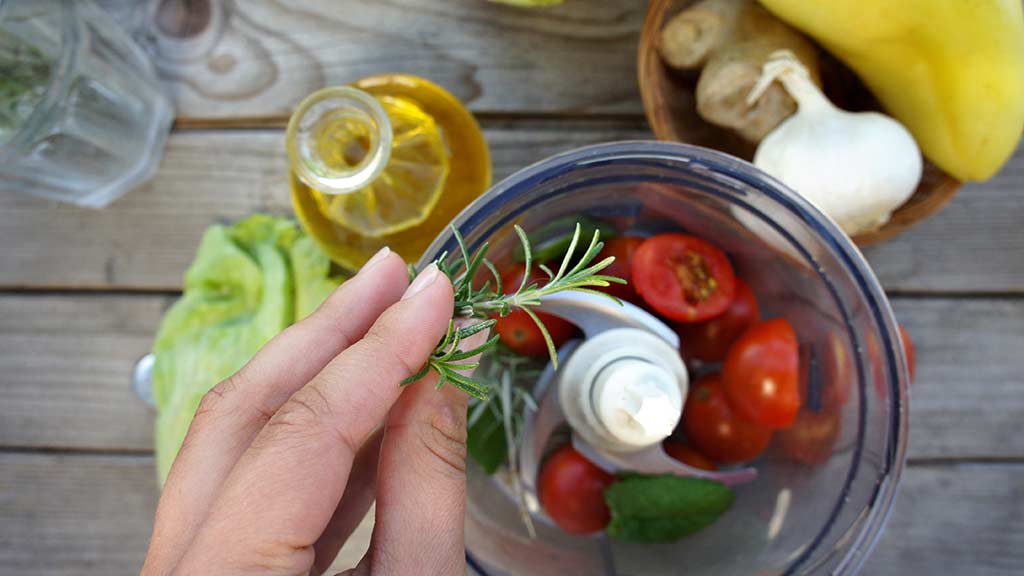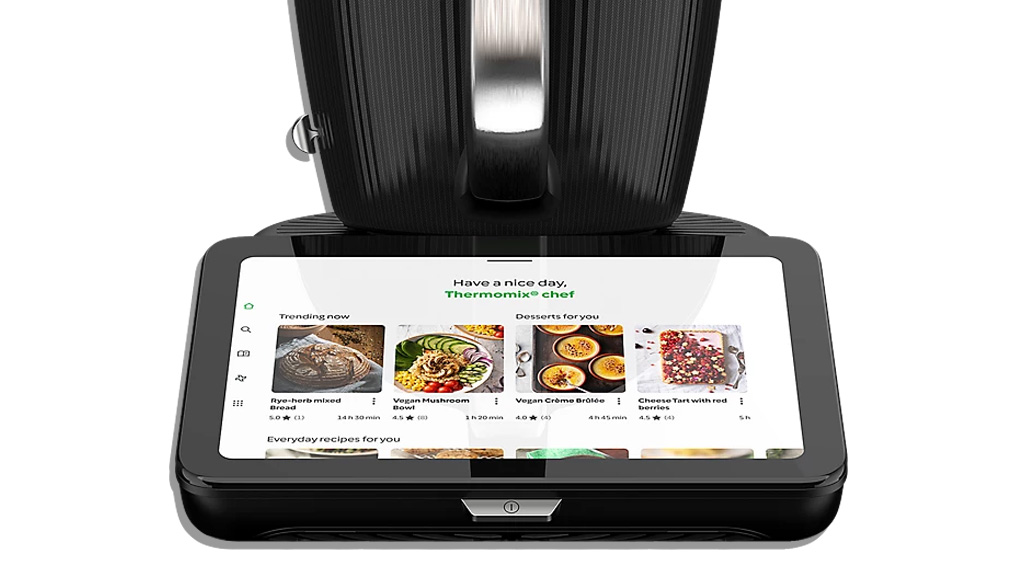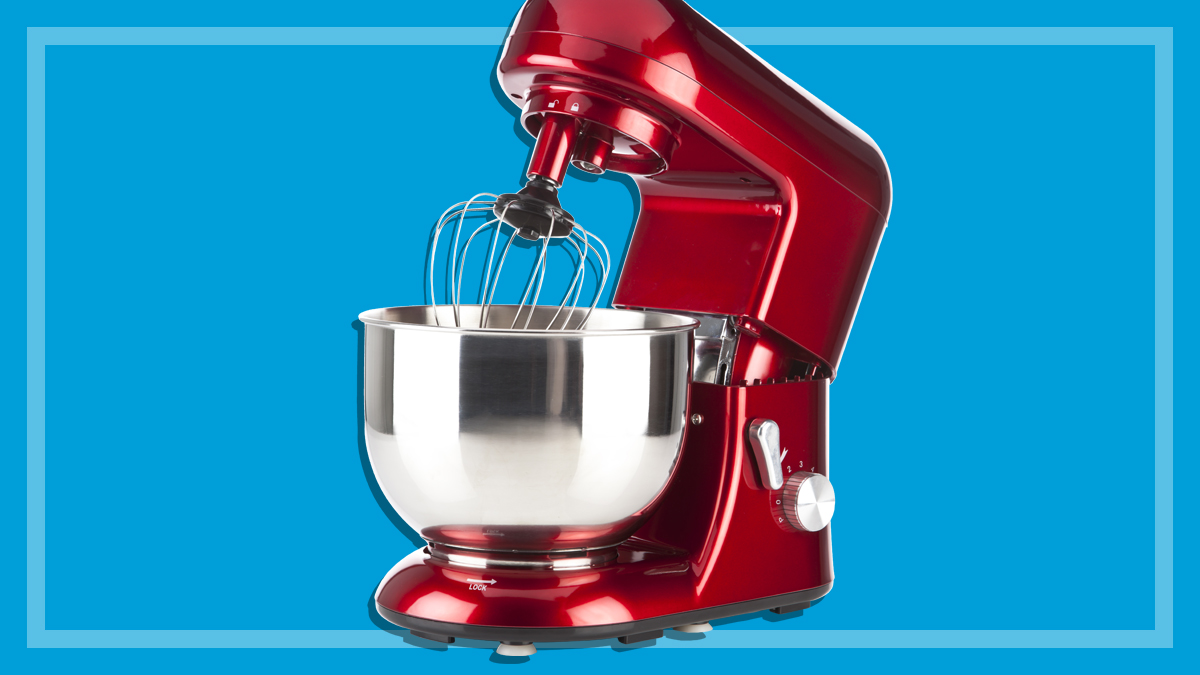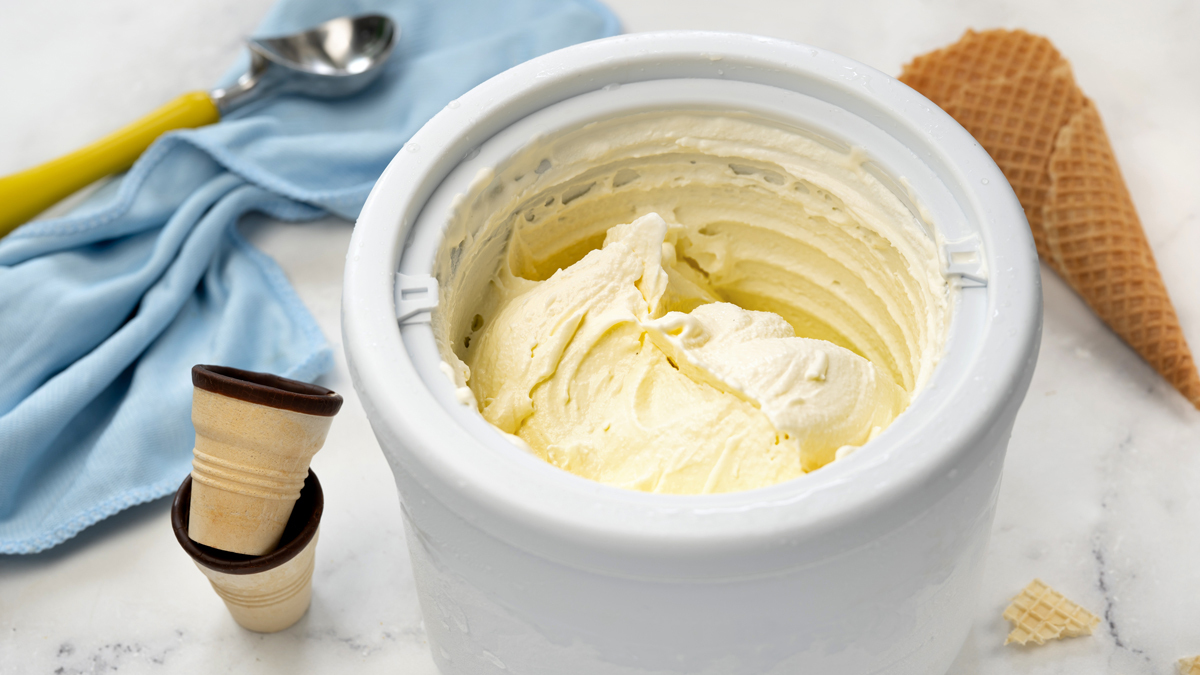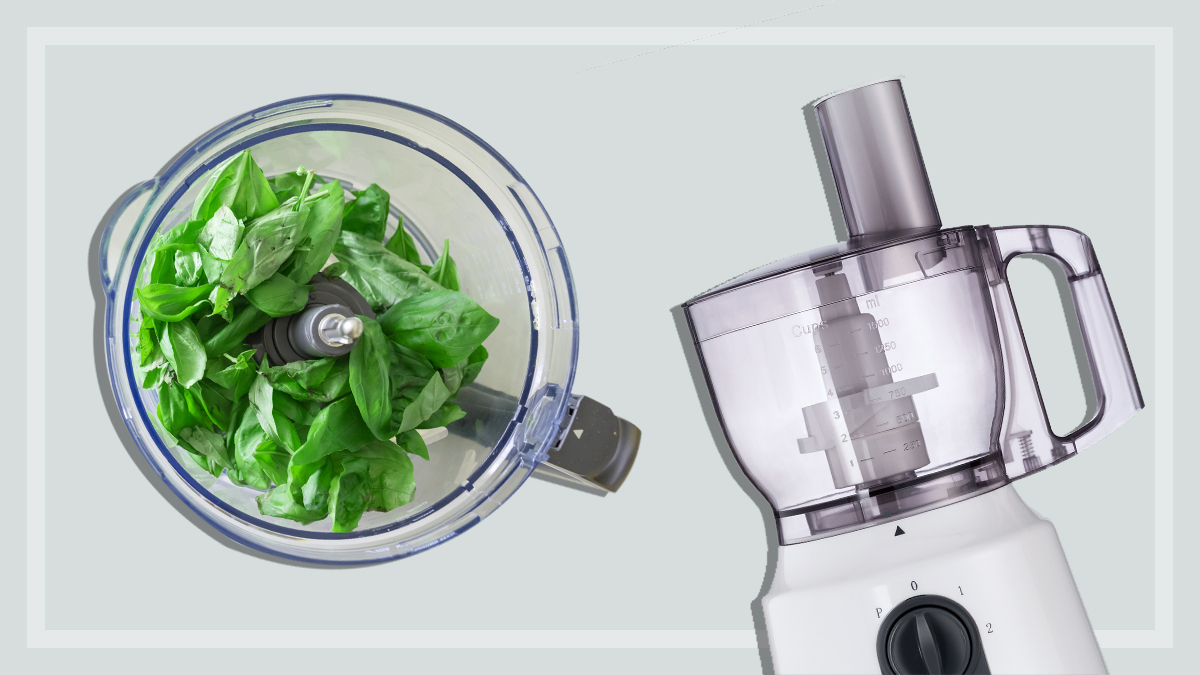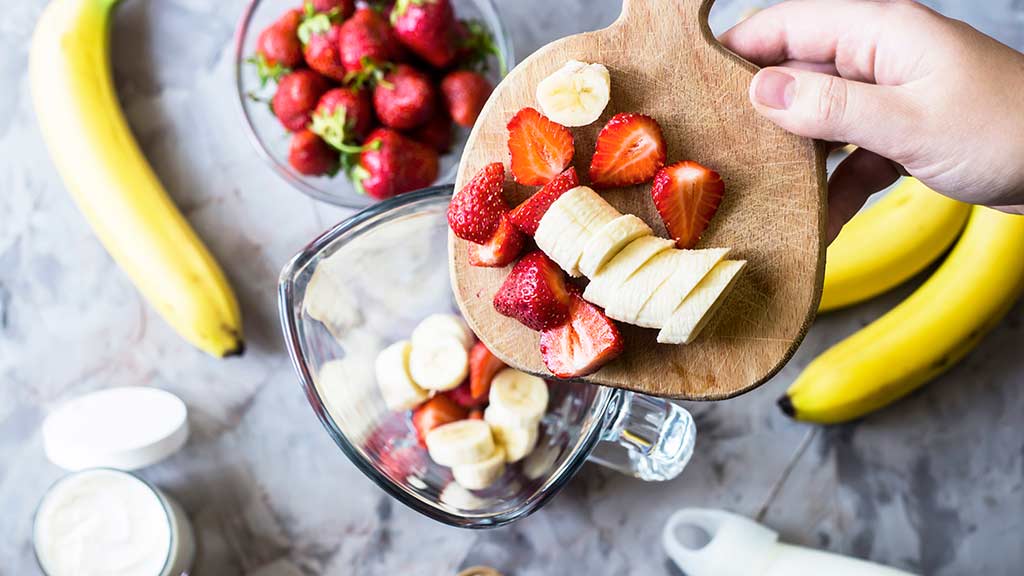The difference between processors, mixers, blenders and all-in-ones
Our kitchen whizz Fiona helps explain why you'd use which machine, and when.
Last updated: 12 Nov 2020
You want to make a cake, so you need a stand mixer, right? And a blender for smoothies, and a food processor for finely chopping veggies. But hang on… your food processor can also mix cakes, your blender can do the veggies, and mixers come with attachments for all sorts of extra functions.
And what about if you want to juice, make nut butters, and crush ice? Just to confuse things further, there’s the much-hyped all-in-one kitchen machine, like the Thermomix, which apparently does everything but set the table.
So which machine do you actually need?
We explain the pros and cons of all the appliances in this category so you can make sure your kitchen’s equipped with the tools you’ll use the most.
All-in-one kitchen machines
Popular models include the Thermomix, BioChef Mycook, KitchenAid Cook Processor, Magimix Cook Expert and Tefal Cuisine Companion.
Why you need one
- It cooks, steams, stirs, chops, mills, weighs (if scale is built-in), grinds, blends, emulsifies, kneads and mixes.
- Replaces a benchtop and handheld mixer, steamer, mini food processor, grinder, blender, scales and a mill.
- If you a have cupboard full of small appliances and want to declutter your kitchen.
- It saves time in the kitchen and enables you to do other things while you’re cooking.
- Makes butter, yoghurt, rice flour, nut milks, spice mix, pastry, bread doughs, pizza, focaccia dough, nut butters, stock paste, baby food, drinks, smoothies, sorbets, ice creams, jams and marmalades, sauces, steams (meats, dumplings), risottos, casseroles, soups and grinds coffee.
- Suitable for anyone from a busy family, newlyweds and young people moving out of the family home. Both novice and professional cooks will find it useful as it can make tedious jobs such as chopping and stirring easier. It’s also a good way to introduce cooking to children.
Why you don’t need one
- Expensive – some can cost more than $2000.
- If you already have a benchtop mixer, steamer, mini food processor, grinder, blender, scales or mill, and are comfortable and happy using these appliances.
- They can’t shred, slice or grate unless they have a food processor attachment.
- Limited in-bowl capacity if you have a large family.
- They can be very noisy.
- Requires a willingness to learn how to prepare food in a different way than what you may be used to.
- Cleaning can be a hassle as the bowls can trap food odours and it can be a chore to clean thick batter or other foods off the blade or from the side of the bowl.
- There may be a steep learning curve with the controls.
Must-have features
- The instruction booklet should be very comprehensive and include a good selection of basic recipes as this is a different way of cooking and personal recipes will need to be adapted.
- Online support with extra cooking lessons available.
- Access to ongoing support from the manufacturer or consultants that will keep you up to date with new recipes and upcoming demonstrations via email.
- Safety features – limits speed cut-out at high temperatures above 60°C, locking lid and a locking cap in lid.
- Be aware of any additional attachments you may need to buy to complete the all-in-one functions, such as dry bowl, kneading hook and recipe chips/discs.
Standard blenders
Popular brands include Breville, KitchenAid, Electrolux, Sunbeam, Kenwood and Cuisinart.
Why you need one
- Have a larger capacity for blending smoothies and soups.
- Traditional blenders can emulsify mayo, puree soup, make smoothies and blend frozen drinks and cocktails.
- Relatively cheap.
Why you don’t need one
- They don’t knead dough, mash potatoes, grind nuts, make nut butters, chop vegetables or finely chop breadcrumbs.
- May not give you silky smooth smoothies or blend fibrous, leafy vegetables very well.
- Can be noisy.
Must-have features
- Suitable for crushing ice.
- Feature a pulse function.
- Have a secure lid that’s easy to remove.
High-performance blenders
Popular brands of these ‘super blenders’ include Vitamix, Breville, Optimum, Oster, Blendtec, KitchenAid and BioChef.
Why you need one
- High-performance blenders are suitable for emulsifying dressings and mayonnaise, pureeing soup, making silky smooth smoothies and blended cocktails, sorbet, grinding nut butters and crushing ice. Some spin so fast they can even heat raw vegetables and liquids to a gentle temperature, resulting in a quick and healthy soup.
- If you’re committed to a healthy diet and want velvety-smooth smoothies, purees and soups.
- Construction-wise, they’re more solid than cheaper blenders.
Why you don’t need one
- Expensive
- Can’t knead dough or mash potatoes.
- May need to purchase a costly dry jug for grinding.
- Can be bulky, which uses up valuable bench and cupboard space.
- They can be very noisy.
Must-have features
- Plastic jug – they’re lighter when filled to capacity.
- Pre-programmed settings for soups, smoothies and crushing ice.
- Secure lid that’s easy to remove.
- Tamper for nut butters and sorbets.
Single-serve blenders
Also known as personal blenders, popular models include the Nutribullet, Nutri Ninja and MagicBullet.
Why you need one
- Blends fruits and vegetables to a liquid and lets you drink on the go from the same bottle. Some water is usually added to aid with the blending.
- It’ll help you to get wholefoods into your diet in a drinkable form.
- Can increase your RDI of fruit and veg intake.
- Great way for kids to get fruit and veg into their diet.
- Suitable for busy people heading off to work and school kids who can whip up a healthy drink of blended fruits and vegetables every day without much supervision.
Why you don’t need one
- They’re not as powerful as high-performance blenders.
- Typically operate on a pulse function.
- You can usually only process for a maximum time of one minute before you need to add a liquid to the fruit and vegetables to blend.
- The juice can warm slightly after processing, so you may need to add few ice cubes or frozen fruit when blending to avoid heating the smoothie.
- You dislike pulpy, frothy drinks.
- They can be noisy.
Must-have features
- Suitable for crushing ice (you may need to add a little water).
- Removable blade shaft.
- Secure, leak-free lid.
Food processors
Popular brands include Breville, Cuisinart, Kambrook, Magimix and Sunbeam.
Why you need one
- Makes labour-intensive tedious prep jobs quick and easy.
- Replaces the mandolin, the grinder, the mixer, the mortar and pestle and the box grater.
- Great for making pastry and doughs, grating, shredding, and slicing fruits and vegetables and grating hard cheese. Makes dips, curry pastes, batters and mayonnaise and finely chops bread crumbs.
- People who are looking to save time in the kitchen but who like to make everything from scratch.
- People who prepare a lot of fruits and vegetables – i.e. vegans and vegetarians.
Why you don’t need one
- It’s not suitable for blending soups, cocktails and smoothies unless it comes with a blender attachment.
- They can be bulky, which uses up valuable bench and cupboard space
Must-have features
- Small and large bowl capacity.
- Storage for attachments.
- If you want to blend liquids look for a watertight seal and a liquid maximising disc that sits inside the bowl and stops liquids from rising up the bowl and leaking out of the lid.
- Adjustable slicing disc, chip blade, two-size grating and shredding blade.
Kitchen stand mixers
Also known as benchtop mixers. Popular brands include Breville, Kenwood, KitchenAid and Sunbeam.
Why you need one
- Kneads dough, mixes batter and whisks cream and egg whites.
- Some benchtop mixers accommodate other attachments as an optional extra such as a mincer, pasta machine, blender, citrus juicer, sausage machine, food processor and fruit press.
- They have large capacity bowls for making larger quantities.
- Suitable for people who like to just bake cakes, breads, biscuits, meringues, marshmallows, choux pastry.
Why you don’t need one
- Limited functionality if they can’t accommodate the optional extras like the ones mentioned above.
- Can be expensive.
- It can’t blend, chop or puree.
- May not be able to accommodate small quantities such as whisking two egg whites.
- If you have limited bench space and cupboard space.
Must-have features
- Single beater attachments, which include a scraper beater, whisk and dough hook.
- Splash guard that lifts off with the motor head and makes scraping the bowl easier.
- Suction feet for stability on the bench when mixing heavy doughs.
Hand mixers
Popular brands include Kenwood, Breville, KitchenAid, Bodum, Sunbeam.
Why you need one
- Beating egg whites, whipping cream, blending cake batters, mixing icing and making smooth creamy mash potato.
- Great for small quantities.
- Easy to store.
- Some include mini attachments such as a mini processor and stick blender.
Why you don’t need one
- You’re not into baking.
- Due to having to hold the mixer, they’re unable to knead doughs or heavy biscuit doughs and batters very efficiently.
Must-have features
- Easy thumb access to controls when mixing.
- Storage container for beaters.
- Comfortable non-slip grip handle.
- A count-up timer.
- Should be lightweight.
- Good standing stability on the bench.
Stick blenders with mini food processors
Popular models include Bamix, Braun, Breville, Kenwood, Panasonic and Philips.
Why you need one
- A stick blender is great for emulsifying mayo, puréeing soup in the pot, processing small batches of baby food and whipping cream.
- A mini processor is great for finely chopping a single vegetable, making mayonnaise, pesto and dips and chopping or grinding small batches of bread crumbs and nuts.
- A mini processor is suitable if you have limited space for a large food processor.
- A stick blender is suitable if you like to make creamed or pureed soups and blend straight in the cooking pot rather than transferring batches of hot soup to a blender.
- A mini processor is great for a single or couple household.
- Helps with the tedious prep and allows you to make foods from scratch.
Why you don’t need one
- If you want to shred and slice, mini-processors don’t usually come with a shredder or slice attachment (larger mini processors may come with one size).
- The stick blender and mini-processor aren’t suitable for pastry doughs.
Must-have features
- A mini-processor bowl with at least a 500ml capacity.
- A stick blender that has a large capacity jug/beaker.
- Stainless steel shaft on the stick blender as the plastic shafts can stain.
- A pulse function.
Related
Fiona Mair tests and compares appliances in the CHOICE kitchen lab, from ovens, cooktops, BBQ's and air fryers, to espresso machines, blenders, food processors, microwaves, frypans and more. Fiona is also involved in Test Research, to help manufacturers with their product development for kitchen appliances. Fiona also conducts and judges food taste tests and is a judge for Sydney Royal Fine Food Show. She develops consumer-focused recipes and technical methods for testing kitchen appliances.
Fiona has a degree in home economics and dietary supervision. Fiona has been at CHOICE since 1997 and previously worked as a dietary supervisor at a children's hospital.
Fiona wants to help people to save time and money in the kitchen, reduce waste and landfill and to enjoy eating foods they've prepared from scratch.
You can find me on LinkedIn.
Fiona Mair tests and compares appliances in the CHOICE kitchen lab, from ovens, cooktops, BBQ's and air fryers, to espresso machines, blenders, food processors, microwaves, frypans and more. Fiona is also involved in Test Research, to help manufacturers with their product development for kitchen appliances. Fiona also conducts and judges food taste tests and is a judge for Sydney Royal Fine Food Show. She develops consumer-focused recipes and technical methods for testing kitchen appliances.
Fiona has a degree in home economics and dietary supervision. Fiona has been at CHOICE since 1997 and previously worked as a dietary supervisor at a children's hospital.
Fiona wants to help people to save time and money in the kitchen, reduce waste and landfill and to enjoy eating foods they've prepared from scratch.
You can find me on LinkedIn.

